Column: Parking Oversight, Please
On-street metered parking in and near downtown Ann Arbor costs $1.50 an hour. Rates have not been increased since September 2012. By the terms of the contract under which the Ann Arbor Downtown Development Authority (DDA) operates the parking system on behalf of the city, the DDA – not the city council – has the authority to raise rates.
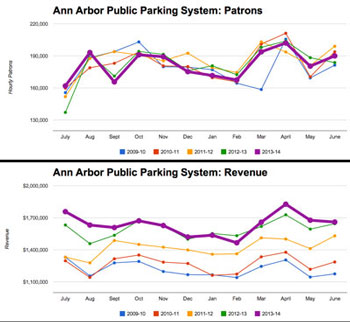
Comparing the periods October 2012 through June 2012 to October 2013 through June 2014 – when rates have been constant – revenue has increased 1.20% to $14,647,274, while the number of hourly patrons has decreased by 1.65% to 1,661,256. (City of Ann Arbor public parking system data from the Ann Arbor Downtown Development Authority, charts by The Chronicle.)
What if on-street metered rates were raised a dime, and rates across other parts of the parking system were also raised by an equivalent percentage?
Although the DDA operates the parking system, that kind of 6.7% rate increase would directly benefit the city’s general fund. By how much?
First, any increase to the city’s general fund revenue is a function of the contract with the city of Ann Arbor, under which the DDA operates the roughly 8,000-space public parking system. The contract stipulates that the city receives 17% of gross parking system revenues.
Total parking system revenues are budgeted by the DDA for the 2015 fiscal year at about $19.3 million. So in ballpark numbers, the 17% equates to a roughly $3.2 million transfer to the city. Of that $3.2 million, about $2.3 million will go to the general fund, while the remaining amount will go to the fund the city uses to maintain downtown streets. That division of the transfer payment by the city has its historical roots in an arrangement between the city and the DDA that predated the existing contract.
So a 6.7% increase in rates across the parking system – assuming no decrease in the use of the system – works out to something like $150,000 more for the city of Ann Arbor’s general fund.
The city council’s role in setting parking rates is one of oversight, not decision-making. But even that oversight role is structurally somewhat weak – because decisions made by the DDA (to raise parking rates) can make the city council’s annual budget decisions somewhat easier.
The next scheduled opportunity for the Ann Arbor city council to exercise oversight of the DDA will be during a fall joint work session – which is stipulated to occur under terms of the city-DDA parking contract. That session is currently planned for Sept. 8.
The contractually stipulated work session would be a good opportunity for councilmembers to ask for metrics on Ann Arbor’s public parking system. Requested information should include stats that indicate how well Ann Arbor’s public parking system supports three different key user groups: (1) downtown employees; (2) retail/transactional customers and visitors; and (3) downtown residents.
Some data is collected routinely by the DDA from Republic Parking – its contractor for day-to-day operations – and shared publicly. That data is limited to revenue figures and numbers of hourly patrons. The routine data does not include hours parked by different categories of users – monthly permit holders and hourly patrons – which makes it difficult to evaluate the system’s support of different user groups.
Still, it’s possible to discern some patterns and to draw some conclusions about Ann Arbor’s parking system, based on the data the DDA does provide. Charts with commentary are presented below.
Overall Picture
The most recent rate increases in Ann Arbor’s public parking system were implemented in September 2012.
Rates for the roughly 2,000 on-street metered parking spaces are currently $1.50 an hour. Rates at surface lots straddle that $1.50 hourly rate – at $1.40 for the first three hours and $1.60 for the fourth hour and beyond. Hourly parking at parking structures costs $1.20 per hour. Monthly permits – which don’t guarantee a permit holder a specific space, but are tied to a particular structure – cost $145 a month at most structures.
Some, but not nearly all, of the monthly permits sold in the two-year-old underground parking garage at Library Lane were initially sold at a discounted $95 introductory rate, which reflects a $50 savings over most other structures. The discount was offered to employees of “new-to-downtown businesses” and to permit holders in the Maynard or Liberty Square parking structures who were willing to transfer their permit to Library Lane. The pricing is good through August 2014. Assuming all those discounted Library Lane permit holders retain them after August 2014, revenue per space at Library Lane should show a slight increase.
The most recent revenue data from the Ann Arbor DDA on Ann Arbor’s parking system is through June 30, or the end of the fiscal year 2014. The most recent three fiscal quarters provide the most meaningful year-over-year comparison – because of the rate increase that was implemented in September 2012.
The most recent data is consistent with the parking reports over the last several years, when interpreting the data has required accommodation of rate increases: Revenue has increased even while the number of patrons who pay the hourly rate in structures or on surface lots has decreased. Hourly patrons don’t include those who park at on-street meters. Specifically, comparing the last three quarters of the most recent fiscal year to the last three quarters of the previous fiscal year, revenue has increased 1.20% to $14,647,274, while the number of hourly patrons has decreased by 1.65% to 1,661,256.
In Chart 1 and Chart 2 below, the recently concluded fiscal year 2014 is indicated in dark purple.

Chart 1: Total System Revenue. (City of Ann Arbor public parking system data from the Ann Arbor Downtown Development Authority, charts by The Chronicle.)
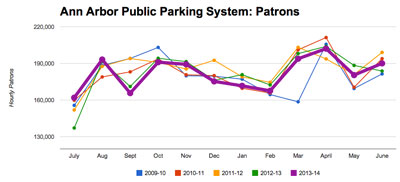
Chart 2: Total Count of Hourly Patrons. (City of Ann Arbor public parking system data from the Ann Arbor Downtown Development Authority, charts by The Chronicle.)
Monthly Permits: Are Fewer Hourly Patrons Staying Longer?
The consistent narrative offered by the DDA to account for the increase in revenues – despite a decreased number of hourly patrons – has been told along the following lines: Even though fewer hourly patrons are visiting downtown, they are parking for a longer time.
It’s possible to ask two basic questions about that narrative: (1) Is it meaningful? and (2) Is it accurate?
In order for the narrative to be meaningful, it’s important to understand how hourly patrons are using the parking system. If hourly patrons are exclusively retail shoppers of some stripe, then the fact that retail shoppers are staying in the downtown longer now than they were in the past could be analyzed as good news for downtown retail establishments. On the other hand, if hourly patrons include a significant number of downtown employees – people who would prefer to hold a monthly permit, but who have been languishing on the wait list – then this might indicate that employees are crowding out retail shoppers.
In order test the narrative for accuracy, it’s important to recognize that hourly patrons are not the only source of revenue to the parking system as a whole. For example, on-street metered parking by itself provided about $3 million of revenue in the most recent three fiscal quarters – but that that type of parking does not contribute to the count of hourly patrons. If the revenue from parking meters and bags is subtracted from the total revenue figure, there’s still an increase – in fact, a greater percentage increase than across total revenues. The $11,529,132 collected for the nine months from October 2013 through June 2014 is about 2% more than was collected from October 2012 through June 2013.
Chart 3 below shows clearly that if on-street metered parking is considered as a facility, then it easily generates the highest gross revenue of any facility in the system.
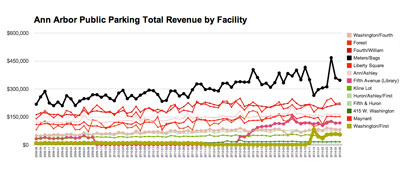
Chart 3: Revenue by Facility. (City of Ann Arbor public parking system data from the Ann Arbor Downtown Development Authority, charts by The Chronicle.)
It is not as straightforward to test the DDA narrative for accuracy with respect to facilities that offer monthly permits as well as hourly parking – where those hourly patrons are counted. The revenue division between monthly permits and hourly patrons is not reported and apparently not analyzed by the DDA. So some of the total revenue increase might be attributable to increased optimization of the oversell margin for monthly permits in parking structures. Many structures show more monthly permits sold than they have spaces. The number of monthly permits sold in the entire system, as well as the percentage of the total inventory, shows a slight but clear upward trend over the last three years.
The DDA does not report monthly permit data broken down by permit type – regular, evening/overnight or premium – which might otherwise help to identify how well users of the public parking system are being served.
Monthly permit data is presented in Charts 4, 5 and 6 below.
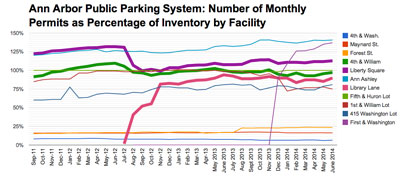
Chart 4: Permits as Percentage of Inventory by Facility. (City of Ann Arbor public parking system data from the Ann Arbor Downtown Development Authority, charts by The Chronicle.)
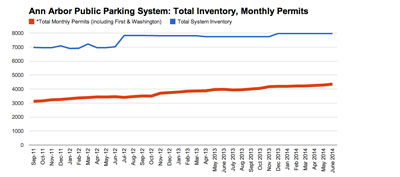
Chart 5: Total Inventory and Total Permits. (City of Ann Arbor public parking system data from the Ann Arbor Downtown Development Authority, charts by The Chronicle.)

Chart 6: Monthly Permits as Percent of Inventory. (City of Ann Arbor public parking system data from the Ann Arbor Downtown Development Authority, charts by The Chronicle.)
For some facilities – like the surface lots at Huron/Ashley/First (the Brown Block) and at South Ashley (the Kline Lot) – no monthly permits are sold. So it’s possible to calculate average payments per patron at those facilities. And both of those facilities show evidence that a fewer number of patrons are generating more revenue, and that their average stay has become slightly longer.
Average payments per patron for Huron/Ashley/First and the Kline Lot are presented below in Charts 7 and 8.

Chart 7: Huron/Ashley/First Average Payment Per Patron. (City of Ann Arbor public parking system data from the Ann Arbor Downtown Development Authority, charts by The Chronicle.)
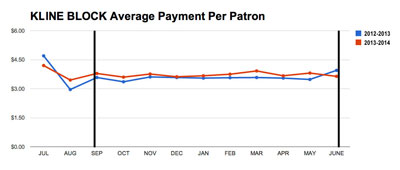
Chart 8: Kline Lot Average Payment Per Patron. (City of Ann Arbor public parking system data from the Ann Arbor Downtown Development Authority, charts by The Chronicle.)
Revenue Per Space
The DDA does not calculate revenue-per-space figures. And the DDA has reduced the frequency of its reporting about the number of spaces at a facility – from monthly to quarterly. So the charts below are constructed based on estimates, using previous number spaces. In any case, most facilities have a stable number of spaces and vary at most by a handful, due to special temporary circumstances.
A couple of clear patterns emerge from the plots of revenue-per-space figures. One is that easily the highest revenue per space (though not per acre of land) is generated by the two surface lots on the west edge of downtown – Huron/Ashley/First and the Kline Lot.
Another trend is that the new Library Lane underground parking garage appears to have achieved a kind of equilibrium in its usage. Library Lane has settled in a bit higher than the lowest performing significant facility in the system in terms of the revenue-per-space metric – which is the on-street metered facility. Library Lane achieved what appears to be its current stable level of usage within nine months of opening.
The on-street facility shows a clear bump for April this year. That coincides with the closing of the Fifth and William surface lot, after it was purchased from the city by Dennis Dahlmann. However, it’s not clear what caused the April increase in revenue to the on-street metered system.
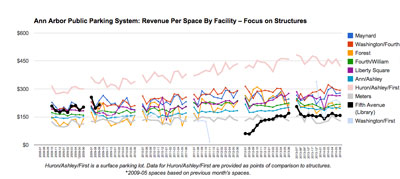
Chart 9: Revenue per Space, Focus on Structures. (City of Ann Arbor public parking system data from the Ann Arbor Downtown Development Authority, charts by The Chronicle.)
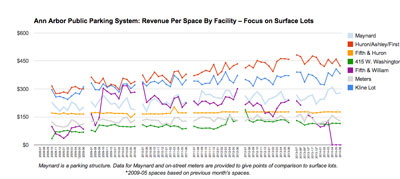
Chart 10: Revenue per Space, Focus on Surface Lots. (City of Ann Arbor public parking system data from the Ann Arbor Downtown Development Authority, charts by The Chronicle.)
Conclusions
Given the kind of parking data currently collected, analyzed and reported by the DDA, it’s not possible to get a very clear understanding of how Ann Arbor’s public parking system is currently supporting three different key user groups: (1) downtown employees; (2) retail/transactional customers and visitors; and (3) downtown residents.
The DDA could improve its understanding of the system by collecting, analyzing and reporting data on hours parked by monthly permit holders as compared to hourly patrons. The hours parked by permit holders should be further broken down by permit type. The DDA could also improve its understanding of the on-street metered system by collecting, analyzing and reporting usage by individual meter – a straightforward possibility at least for those meters that are paid for using the relatively new kiosks.
Certainly there are other fiscal policy issues at stake as the DDA evaluates whether parking rates should be increased. For example, are current revenue levels adequate to pay for existing debt on past construction, the go!pass bus pass program, ongoing maintenance and a possibly $5 million renovation to the Fourth and William Structure? In its oversight role, the city council should certainly include consideration of these basic financial issues.
I’m reasonably confident that the council will exercise appropriate oversight with respect to the purely financial question: Will there be enough money and how much does the city get?
But without a clearer understanding of how the parking system supports different user groups, it will not be possible to measure the impact of a price increase on those user groups.
So at the joint city council-DDA work session on Sept. 8, I hope the city council will include in their oversight role a request for data and metrics that will help answer this question: How does Ann Arbor’s parking system actually work?




Agreed.
And I’ll piggyback. What would also serve everyone better is if you could find on-street parking whenever you wished. This is accomplished in other cities, and it requires pricing on-street parking appropriately according to demand (see every Parking 101 textbook). Every block should have 20% parking vacancy on average so on-street spaces can reliably be found for quick errands, shopping trips, or drop-offs for the elderly or disabled. This means raising on-street prices significantly and more vigorously enforcing time limits. (This would preferably fluctuate by time of day and location like other cities do, but that may be a little too crazy for Michiganders.) Leisurely shoppers, tourists or dining customers will gravitate to the structures or lots, where they can use validated parking passes if a business offers them.
Parking enforcement hours should also be extended to 9pm. This will drastically reduce the “cruising” for free (rather, taxpayer-subsidized) spots at night. And, you know, make the city a good deal of money.
We fret about UM taking land off the tax rolls, fret about not being able to levy local sales taxes, yet we’re highly subsidizing and giving away hundreds of thousands of dollars’ worth in parking storage per year. Why?
Don’t hold your breath, Dave.
@1: “Why?” Excellent question. Don’t you hold your breath either.
Dave, you referenced three categories of the parking population but didn’t discuss the third, downtown residents. I wonder if the DDA’s “narrative” now includes them. Seems like reality probably does. My perspective on it is that their demand, though currently real to whatever extent, will decline even more rapidly than for others. First, those that also work in the downtown (or elsewhere in the city for that matter) can commute and access services without a car (or for a couple or family, with fewer cars). Second, if they work outside the city, they’re more likely to move out of the downtown, taking their parking demand with them. Both thoughts reflect the assumption that financial and economic forces will weigh on not all but many of those residents much more heavily in the near future, leading to car-ownership decisions. Another question that comes to mind is what percentage of them currently own cars and store them in the public system.
UM has an energy survey, which shows that the US consumer is very resistant to increasing gasoline prices, more so than home energy prices: [link]
I suspect consumers are also resistant to increased parking prices based on the comments to annarbor.com when this was last discussed. Folks will drop $80 for dinner and drinks but complain because they had to pay for parking or that they had to pay $4 for parking instead of $3.20. Folks are also sympathetic to the low-paid workers who depend on that free at 6pm meter.
Still, I would encourage the city council to use their parking spaces more efficiently. Charge more for the most popular spots and less for underutilized spots. This does not have to be real dynamic pricing that changes all the time. A few simple changes would do the trick.
Charge more for metered parking and surface lots.
Metered on-street parking should not be free until 9pm
Charge less for the least utilized space – already doing this with some of the metered spaces on the edge of the downtown district, which go for 0.80 an hour. I would love to see different rates for different structures. I am pretty sure folks would continue to fill up the Washington/Fourth structure at a slightly higher price. And, savvy consumers could save money by parking in the Ann structure.
Keep a few odd pricing schemes – the set price after 3pm (Tally Hall pricing scheme) or the $4 daily price for the lot across from the Y. These serve a useful purpose.
Re: “Metered on-street parking should not be free until 9pm”
DrData, for sake of absolute clarity, could this suggestion also be phrased as: “Metered on-street parking should be enforced until 9 p.m. – not just until 6 p.m. like it is now.”?
Yep.
But, who are we kidding? Do we think this article and comments are going to be acted upon?
Omitted constituency: city residents who don’t live downtown. To lump these in with Toledoans or Dearbornites seeking an urbane experience is to 1) dismiss the idea of “Ann Arbor” as more than the DDA zone; and 2) to acknowledge that the Downtown Crowd views the rest of is as nothing more than fodder for the downtown corporate welfare grist mill.
Agreed, John.
However, Dave may be lumping the city residents who don’t live downtown into the “retail/transactional customers and visitors” category, and I would add also Greater Ann Arbor residents who don’t live in the city. This Scio resident makes only very carefully planned trips downtown, and that includes parking planning — and only when there’s no alternative. It’s not really too much of an exaggeration to say that, in general, I avoid Downtown like the plague. For an easier, more pleasant routine shopping and errand trip, I’m likely to go to Dexter. And, as a lifelong Ann Arbor resident and fiercely proud Townie, I think that’s sad.
Re: “However, Dave may be lumping the city residents who don’t live downtown into the “retail/transactional customers and visitors” category,…”
Yes, I meant that to be a description of a behavioral category not a description of geographic origin. But I think it’s still useful to ask the question implicit in Floyd’s comment: Where are retail/transactional customers and visitors coming from? One low effort way (compared to windshield flyer surveys, for example) to get some initial insight would be to analyze the zip code information collected from those who use credit cards to pay at on-street metered kiosks.
I live within easy walking distance of downtown (and also do not own a car) so parking in the downtown area is not an issue for me. However, I agree with Lyn @8 about not shopping downtown. My reasons may be different from hers. Downtown is now what I would call an entertainment center. Main street and adjacent blocks consist of restaurants, gift shops, galleries, night clubs. There is no food store,(except quite expensive ones near campus), no hardware store, no department store, no place to buy a dishpan. All these “regular” stores have been forced out by high rents and (we come full circle) “no place to park”.
@ 8 & 10, I have lived downtown for nearly 20 years and have found it to have grown more livable over the years, not less. In addition to a twice a week farmers’ market, for food we have a co-op, a meat market, a fish monger, and a high end deli just in Kerrytown. There are many places to find a unique gift item, a toy, a special card and wrapping paper. For household items that you don’t find at the co-op, try Downtown Home and Garden. If you find them pricey, think about the quality. The pans I bought there will last my lifetime and more (although they were certainly heavy carrying home. And in regards to pricing, I have heard the argument that the food choices are just too expensive. While individual items can cost a little more downtown than at Meijer or Kroger, I find that I waste less by buying fresh just what we need, a few times a week. Add in the cost savings of not owning and maintaining a car and that argument really falls flat. Now I am not sure where you find a dishpan downtown, (and I am not really sure what one is) I bet you can find one at Kiwanis.
Sandi – You are correct that many items are available downtown. I don’t mind paying more for quality goods. I do shop at Kerrytown, The food Co-op, Farmer’s Market, Downtown Home and Garden. I was thinking of “downtown” as mostly Main St and adjacent blocks where there used to be 2 hardware stores, department store, toy store, work-clothing store, etc. These are what I call “regular” stores. I realize that downtown areas must change in order to remain viable but I miss being able to do most of my everyday shopping in town.
Re dishpan – since I don’t have a dish-washing machine I wash dishes by hand and use a dishpan rather than filling up the sink with hot water.